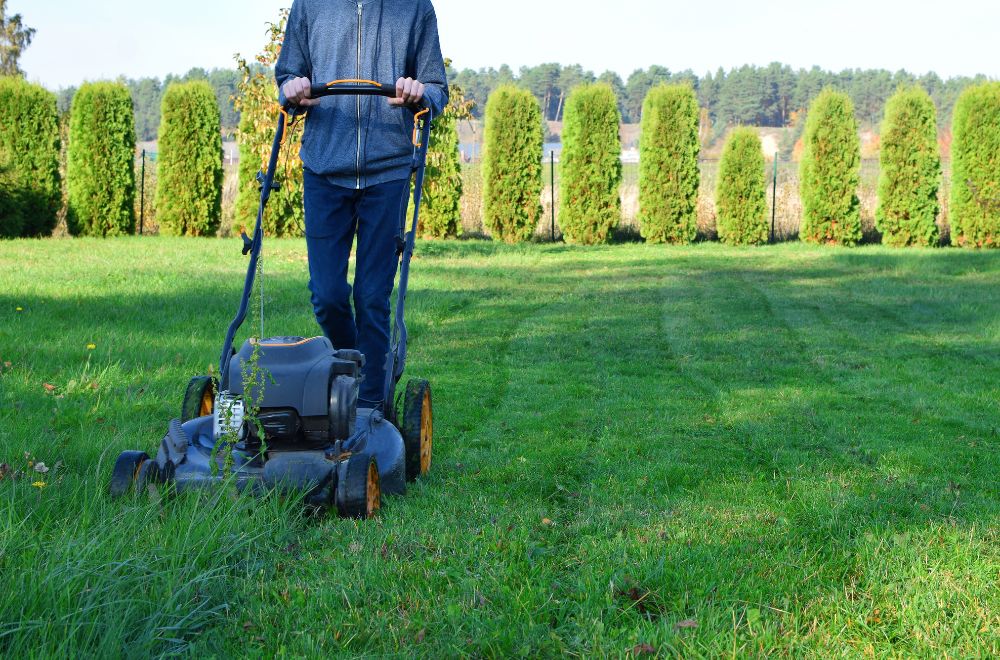Some people enjoy mowing the lawn, but many don’t, and when you’d rather be sitting in the sun reading a book or drinking a beer, cutting the grass can be an unwelcome chore. However, even for those who hate mowing the lawn, there is a silver lining – just like any other physical activity, tending to you grass burns calories.
Ok, so it might not burn as much fat as running a marathon, but it still counts and is a great way to get a little exercise, especially if you have an otherwise sedentary lifestyle. Here, we look at the question, how many calories does mowing the lawn burn?
Here’s a video of someone measuring the number of calories using a fitness device – by the end of this post, you will be able to judge whether this matches the calculations we give you below.
Why it’s not such a straightforward question
Unfortunately, the answer to our question is not quite as simple as it might sound – and this is because there are many factors that can affect the number of calories burned when cutting the grass.
This means before we can look at how many calories are burned when mowing the lawn, we need to look at some of the variables that can affect the calculation.
How much you weigh
One of the most important is how much you weigh. When you exercise, the heavier you are, the more energy you use and the more calories you burn.
For example, somebody weighing 125lbs who walks one mile will burn fewer calories than someone weighing 175lbs who walks one mile.
The same is true of mowing the lawn, so one reason there is no simple answer to this question is that it depends on how much you weigh.
The type of lawnmower you use

Another major factor to consider is the type of lawnmower you use. Evidently, if you use a riding lawn mower, you will use a lot less energy than if you are pushing your lawnmower manually.
In between riding lawnmowers and old-fashioned manual push mowers are self propelled lawn mowers – these will cause you to burn more calories than a mower you sit on but less than one where you have to push it yourself.
Even using something like a cordless weed eater will burn calories, but again, the number of calories burned will be different.
How vigorously you mow
Another factor is how vigorously you mow your lawn. If you take your time and don’t break a sweat, you will burn fewer calories than if you charge around your yard mowing as quickly and energetically as you can.
What is the terrain like?
The conditions in your yard can also affect how many calories you burn. For example, if you are mowing an uneven lawn where you need to push a mower up and down hills, you will burn more calories than if you are mowing a perfectly flat lawn.
Similarly, even the length of the grass can have an effect – if you are cutting long, tough grass that hasn’t been looked after, you will end up using more energy than if you are giving a carefully manicured lawn its fortnightly trim.
So how many calories?

So, having mentioned all the factors that can affect how many calories mowing the lawn burns, now let’s look at how to work out some figures.
· Method one – a rough calculation
The simplest way to calculate the number of calories is as follows:
Without taking many of the factors mentioned above into account, we can say very roughly that a 125lb person burns 3.8cal/minute, a 150lb person burns 4.6cal/minute and a 175lb person burns 5.2cal/minute.
To work out how many calories you burn when mowing the lawn, you simply multiply this number by the amount of time in minutes it takes you to mow the lawn. So, for example, if it takes one hour to mow the lawn:
3.8 x 60 = 228 calories (for a 125lb person)
4.6 x 60 = 276 calories (for a 150lb person)
5.2 x 60 = 312 calories (for a 175lb person)
Of course, this method doesn’t take into account factors such as conditions in your yard, the type of mower you are using and so on – it just gives you a very rough idea of the average number of calories you might be burning according to your weight.
· Method two – using MET
For a slightly more accurate figure, you can do a calculation using MET.
MET stands for Metabolic Equivalent of Task and is a way of calculating how many calories are burned depending on the strenuousness of an activity.
MET 1 is the equivalent of sitting still in a room temperature room while not actively digesting food. MET 2 is an activity that uses twice as much energy as when in this resting state, and so on.
By knowing the MET rating for using each type of mower, we can calculate more accurately how many calories are being burned.
A riding mower has a MET of 2.5, a self-propelled mower has an MET of 4.5-5 and a regular push mower has an MET of 6. The calculation is as follows:
(MET x body weight in kg x 3.5 / 200) x time in minutes
Let’s look at one example to work out the number of calories burned by a person weighing 125lbs and using a riding mower for one hour.
125lbs = 56.7kg
2.5 x 56.7 x 3.5 / 200 = 2.48
2.48 x 60 = 148.8
So a 125lb person mowing the lawn for an hour on a riding mower would burn 148.8cal.
Without going through the calculations, here are some other examples:
150lb person on riding mower – 178.5cal
175lb person on riding mower – 208cal
125lb person with push mower – 357cal
150lb person with push mower – 428cal
175lb person with push mower – 500cal
For self-propelled mowers, the figures probably lie somewhere in between.
There two main points to take away from these calculations:
- There is wide variation depending on the weight of the person doing the mowing and the type of mower used
- Mowing the lawn for an hour can represent quite a significant workout!
Wide variation – but it’s all exercise
As we have seen, there are many factors that can affect how many calories you burn when mowing the lawn, making it impossible to give a single answer. However, any kind of lawn mowing burns calories – and the most strenuous types of lawn mowing can burn as many calories as a moderate workout in the gym!

Leave a comment